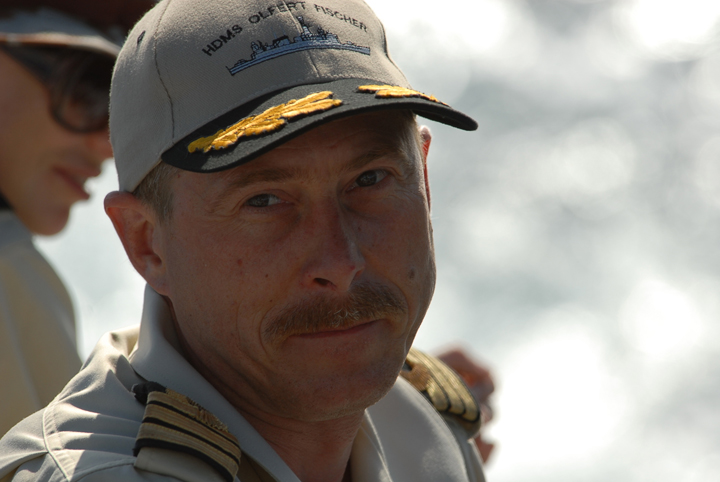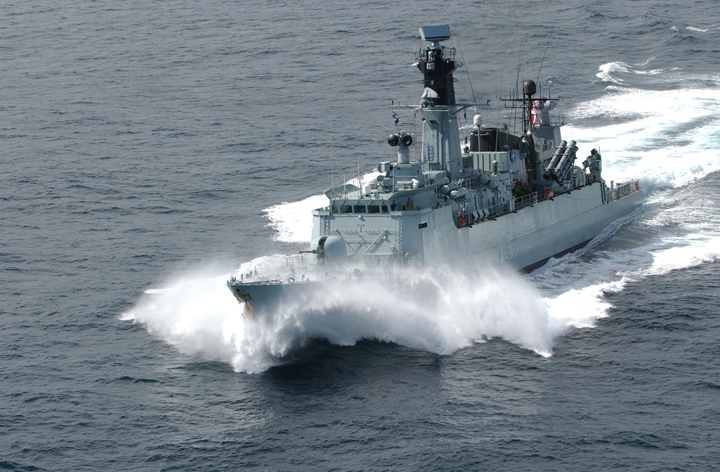Around Africa with the Royal Danish Navy
Little ship from Denmark has big impact on NATO operation. A NATO naval force made history in 2007, circumnavigating the African continent while combating pirates off both eastern and western Africa
-
 The crew of Danish warship HDMS Olfert Fischer
The crew of Danish warship HDMS Olfert Fischer -
-
and holding the first-ever joint exercises with the South African Navy.
Through it all, the smallest ship in the flotilla showed size really doesn’t matter. -
 Commander Per Ertloev Hansen
Commander Per Ertloev Hansen -
-
“It was an eventful deployment,” said Commander Per Ertloev Hansen, captain of the HDMS Olfert Fischer. “For the Olfert Fischer crew, manning by far the smallest ship in the group … with only two planned port visits on the voyage around Africa, the endurance for a ship designed and built for operations much closer to homeland bases and logistic support centers was challenged to the limits.”
The Royal Danish Navy spent several months selecting crew for the mission. Hansen said selecting the Olfert Fischer for the voyage, however, was an easy decision.
“As Olfert Fischer already has proven to be able to deploy far from Danish waters the circumnavigating Africa task initially seemed a straightforward assignment,” Hansen said. “However, as the smallest ship in the group Olfert Fischer had to be well prepared, tuned and the crew sufficiently trained.”
Olfert Fischer was part of Standing NATO Maritime Group 1 (SNMG-1), a force of six warships from six alliance countries. The largest ship was the flagship, the American guided missile cruiser USS Normandy. With a length of 573 feet and a displacement of 9,000 tons, the Normandy dwarfed the 273-foot, 1,320-ton Danish warship. Normandy commander Capt. Robert S. Kerno said the size of “Olfie” surprised much of the squadron.
“I remember the first time I saw her I thought, ‘Wow, that’s a pretty small ship to go around Africa,’” Kerno said. “But I’ll tell you, for a small ship that took a pounding, she was always on station. She had a hardy crew and a good commander.”
The Danish boat, as the smallest in the group, was often in the lead, working inshore as part of a screen for the force. Kerno said it was a perfect mission for the Fischer.
“Their size meant they weren’t unwieldy.” Kerno said. “They’re good at ASW (anti-submarine warfare) and very capable. They were also very good at foul weather operations. They could put out small boats in the worst conditions.”
The Danish warship opened more than a few eyes when SNMG-1 rounded the notorious Cape of Good Hope at the tip of South Africa. Currents from the Atlantic and Indian oceans collide off the Cape. The result is tumultuous seas that can tower at 60 feet and hurricane-force winds. As the group rounded the cape, it ran smack into a nasty storm that had even the most stoic sailor feeling a bit queasy.
Hansen played down the storm, saying only the Fischer had an “eventful passage” around the Horn. Kerno was somewhat more descriptive.
“There were times when we couldn’t even see the Olfie,” he said. “That little boat certainly bounced a lot. I know how much we were rolling and we’re twice the size of her, so I can only imagine what it was like for them. That was a brave little ship and she earned the respect of everybody in the group.”
SNMG-1 is one of four standing maritime groups in the combined NATO fleet. It is part of the alliance’s rapid reaction force and is on duty 24 hours a day, seven days a week. Although it is up to the six nations in SNMG-1 to decide which ships they will contribute, the component countries don’t change. Portugal, Germany, Holland, Canada and the United States as well as Denmark contribute to SNMG-1.
NATO said one of the main reasons for the circumnavigation was to combat an old problem.
“We are seeing a worrying trend of threats to maritime security. It is deeply embarrassing in the 21st century that ships carrying corn and maize are being threatened not by missiles but by pirates,” said Admiral Sir James Burnell-Nugent, Commander Allied Maritime Component Command in Northwood, England. “NATO maritime forces have a crucial role to play in building Maritime Situational Awareness (MSA), monitoring what is going on in the maritime domain and compiling a picture of the movement of vessels, shipping patterns and activities over a period of time.”
Following anti-piracy operations off the coast of Nigeria and Guinea, the group made passage to Cape Town, South Africa. Although other Danish ships have crossed the Equator, Olfert Fischer became the first Nils Juel-class warship to make the crossing. In keeping with tradition, the five crewmen who were “Shellbacks” – sailors who previously crossed the equator – prepared a ceremony for the 88 “pollywogs” – sailors that have not crossed the line.
“The ceremony gave a nice break from the daily routines onboard during the 23-day long voyage towards South Africa,” Hansen said. “The shellback event also marked the shift of focus from presence operations to concentrate on exercises with the South African National Defense Forces.”
After a several days of exercises with the South African Navy, SNMG-1 continued its way around Africa. Along the way, Olfert Fischer provided aid to a becalmed British yacht, Hansen said, and also was part of search-and-rescue operations off Yemen following the eruption of a volcano. The group cleared the Suez Canal on Oct. 6, 2007, to complete its 12,500-nautical mile circumnavigation. For Hansen and the Olfert Fischer, the voyage around Africa was proof not only that size doesn’t matter but that small packages can pack a big punch.
“Olfert Fischer has proven that limits can be moved in an effort to contribute to maritime security, an important for a sea-faring nation like Denmark,” Hansen said. “To stand watch hours night after night knowing you are doing a little difference in the struggle against malice is another major (lesson). The many lessons learned and the experience gained from the deployment will be shared and might come in handy when the next generation of Danish frigates in the coming years are built and deployed.” -
 273-foot, 1,320-ton Danish warship HDMS Olfert Fischer at sea
273-foot, 1,320-ton Danish warship HDMS Olfert Fischer at sea -
Written by Chipp Reid
-
-
